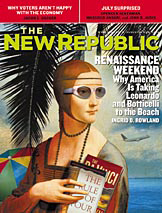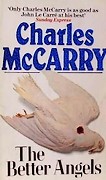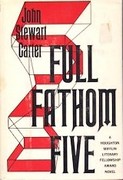“Lost & Found,” from The New Republic magazine

For roughly a year between April 2004 and early 2005, The New Republic magazine published “Lost & Found,” a feature in which writers discussed books and other cultural artifacts they considered to be at risk of being neglected.
As the editors described it at the time,
Owing to the explosion of information in our society, the pressure of cultural forgetfulness seems now, quite paradoxically, greater than ever. “Lost & Found” will present short essays on behalf of books, records, paintings, sculptures, dances, buildings — any cultural production of any sort — that is, in the view of the writer, in danger of oblivion. Impassioned defenses of beloved things.
The feature was an attempt to revive a much-earlier feature from the magazine’s literary pages, “Reconsiderations,” in which writers in various fields sought to re-introduce books that they believed had been unjustly forgotten.
- • Albert Angelo, by B. S. Johnson — selected by Keelin McDonell
- Still, for all the accusations of difficulty, Albert Angelo remains Johnson’s most accessible and prescient work of fiction. The story unwinds in starts and fits but does not trespass against the basic linearity of traditional narrative. And more remarkably, it anticipates many of the novels of multiculturalism and social upheaval that have marked the British literary scene of the past decade.
- • The Better Angels, by Charles McCarry — selected by David A. Bell
 It was an insight that led him, in The Better Angels, to create a character, the terrorist mastermind Hassan Abdallah, who anticipated all too well the leaders of Al Qaeda: implacable, ascetic, driven by few clear political goals, and possessed by a febrile lust for death. This, taken together with the keen portrait of Julian Hubbard, and the shrewd guesses about Internet technology and political polarization, makes The Better Angels a “lost” novel that very much deserves to be found again in this war-shadowed election year.
It was an insight that led him, in The Better Angels, to create a character, the terrorist mastermind Hassan Abdallah, who anticipated all too well the leaders of Al Qaeda: implacable, ascetic, driven by few clear political goals, and possessed by a febrile lust for death. This, taken together with the keen portrait of Julian Hubbard, and the shrewd guesses about Internet technology and political polarization, makes The Better Angels a “lost” novel that very much deserves to be found again in this war-shadowed election year.
- • Bound to Violence, by Yambo Ouologuem — selected by Harold Braswell
- Bound to Violence exposed this mixture of white guilt and stale exoticism for the intellectual garbage that it was. Energetic and ambitious, the book is a stylistically rich novel that has been unfortunately subsumed by the controversy surrounding its author…. To view the novel as nothing more than a response to white influence–whether it be in the form of colonial penetration or discursive control pregnant in the literary institution itself–is to obscure a great book, a book whose inventiveness of form and frothing mix of ideas and characters make it infinitely richer than a facile tale of victimization or rebellion.
- • Deborah, by Esther Kreitman (Translated by Maurice Carr)— selected by Ilan Stavans
- “There are two Singers in Yiddish literature,” Irving Howe wrote in 1980, “and while both are very good, they sing in different keys.” He was wrong. There are three: the master novelist Israel Joshua Singer, his younger Nobel Prize-winning sibling Isaac Bashevis Singer, and also their long-eclipsed older sister Esther Kreitman, who died in neglect in London in 1954…. Kreitman, it must be said, is not a natural storyteller. Her narrative structure is chaotic, even erratic. Her atmospheric descriptions are pungent yet disorienting. The reader has difficulty warming up to her awkward style. But in her case the silences, deliberate and unconscious, are the message. She explores the predicament of women in orthodox families with enviable urgency.
- • An Estate of Memory, by Ilona Karmel — selected by Omer Bartov
- Ilona Karmel’s An Estate of Memory is not simply another important book among what has now become a sub-genre spanning several generations of writers and readers. It ranks with the greatest works ever written on the eclipse of humanity in the mid-twentieth century and must be read by anyone who wishes to gain some understanding of the individual’s experience in the Holocaust, let alone by those claiming some knowledge of its literary representation.
- • Full Fathom Five, by John Stewart Carter’s — selected by Telis Demos
 … [T]he fictional memoir of Anthony Scott, the grandson of a turn-of-the-century robber baron, that tells the story of how he became an unsuccessful professional poet….
… [T]he fictional memoir of Anthony Scott, the grandson of a turn-of-the-century robber baron, that tells the story of how he became an unsuccessful professional poet….
Carter’s critics rightly picked apart his flawed style and narrative, but Carter wasn’t asking anyone to put him in the canon. He was writing because the great writers and thinkers who equipped him to understand life also bequeathed a passion for expression. He knew he wasn’t James or Proust, yet Full Fathom Five‘s critics never failed to point this out. Carter essentially predicted what his critics would say to anything he could write. But he couldn’t stop himself from striving, and he gave us Full Fathom Five as a record of his dying attempt. It’s worth reading for anyone who ever felt the allure of greatness without being able to achieve it themselves.
- • Gondola Days, by Francis Hopkinson Smith — selected by Jenna Weissman Joselit
- What this book does provide — and in abundance — is a vivid sense of the rhythms and sensations of the place. Luxuriating in Venice, soaking up its pleasures, one by one by one, Gondola Days invites its readers to smell the sea, embrace the sun and the rain, splash around in the pools of water that periodically flooded the piazza in front of San Marco (and still do), consume unfamiliar foods, and lie adrift in the belly of a gondola. A form of seduction, Gondola Days offers us a real gift: the next best thing to being there.
- • La Guerre, Yes Sir!, by Roch Carrier (translated by Sheila Fischman) — selected by James S.F. Wilson
- Few works so vividly dramatize the state of being a foreigner in one’s own land, or being foreign to oneself….
The French and English in the book’s title articulate the wedge in the center of the story. In the 1940s, in a town in rural Quebec in the dead of winter, an Anglophone honor guard arrives to deliver the body of a common soldier, Corriveau, to his French Canadian parents. At a brisk pace Carrier sketches a half dozen of the people Corriveau used to know, in varying states of distress (and dress), and in the second half of the book brings everyone together for a messy wake…. As Carrier’s small tragedies unravel, the arc of his short narrative chases little else but time–the time it takes for the villagers to collect themselves for the arrival of Corriveau’s coffin, then to get drunk at the wake; to fight among themselves, then against the Anglais; to bury Corriveau at the end of it all. In organizing his book this way Carrier subjects his tale to a bracing test against reality: what if people cannot be transformed?
- • Memoirs of a Superfluous Man, by Albert Jay Nock — selected by Franklin Foer
- In a lecture in 1999, [William F.] Buckley recounted, “I began reading Albert Jay Nock, from whom I imbibed deeply the anti-statist tradition which he accepted, celebrated, and enhanced.” Buckley hadn’t just known Nock from his oeuvre. During the early forties, Nock regularly lunched with Buckley’s father at the family’s estate, delivering sweeping pronouncements about civilization’s decay. A good portion of the early National Review staff looked upon Nock with similar reverence.
Given the noisy victory dance Christian conservatives are now performing, it is hard to imagine that they are part of a movement that Nock helped launch. But, at its birth, the conservative movement looked a lot more like Randolph Bourne than Ralph Reed–a bit anarchist, somewhat bohemian, occasionally blasphemous, and thoroughly misanthropic. Nock’s Memoirs from a conservative viewpoint, see The Brothers Judd exudes these qualities and has another charming trait: It may be the most splenetic work in all of American literature.
For an enthusiastic review of Memoirs of a Superfluous Man from a conservative viewpoint, see The Brothers Judd website.
- • The Road to Mecca, by Muhammad Asad — selected by Franklin Foer
(Fons Vitae, 375 pp, $17.95, originally published in 1954) 
….[O]ne of the unlikeliest lives of the twentieth century is [that of] the Islamicist diplomat Muhammad Asad. No, he was not born with that name. Muhammad Asad started life as a Galician Jew. At his bris in Lemberg (as the Jews called Lviv) in 1900, he was Leopold Weiss. This descendent of the distinguished rabbis of Chernovitz soon joined the trajectory of Jewish modernization…. A visit to an uncle in Palestine in 1921 changed all that. And here’s where the story takes its strange turn: Instead of swooning for Zionism, he became enraptured with the desert Arab lifestyle. For the next decade, this Galicianer Lawrence traveled through the bazaars, deserts, and mosques of Arabia, Syria, Iran, and Afghanistan. In the process, he became a Muslim himself, a confidant of King Ibn Saud, and a leading proponent of Islamic statehood in Pakistan. The road from Lviv became the road to Mecca.This conversion story is told in his memoirs, The Road to Mecca, which Simon and Schuster first published in 1954. By that time, Asad had settled in New York and served two years as Pakistan’s envoy to the United Nations….
For all The Road to Mecca‘s obeisance to Islam, it fits more comfortably alongside the works of T.E. Lawrence and Gertrude Bell, a European’s romp through the desert. The book begins in an Arabian sandstorm. Asad separates from his manservant, Zayd, circles aimlessly for days, and nearly dies of thirst. Inspired by this traumatic experience, Asad rearranges his itinerary to make a pilgrimage to Mecca. With each stop in the desert, the travelogue dissolves into flashbacks from Asad’s biography showing his progression from Jew to Muslim.
